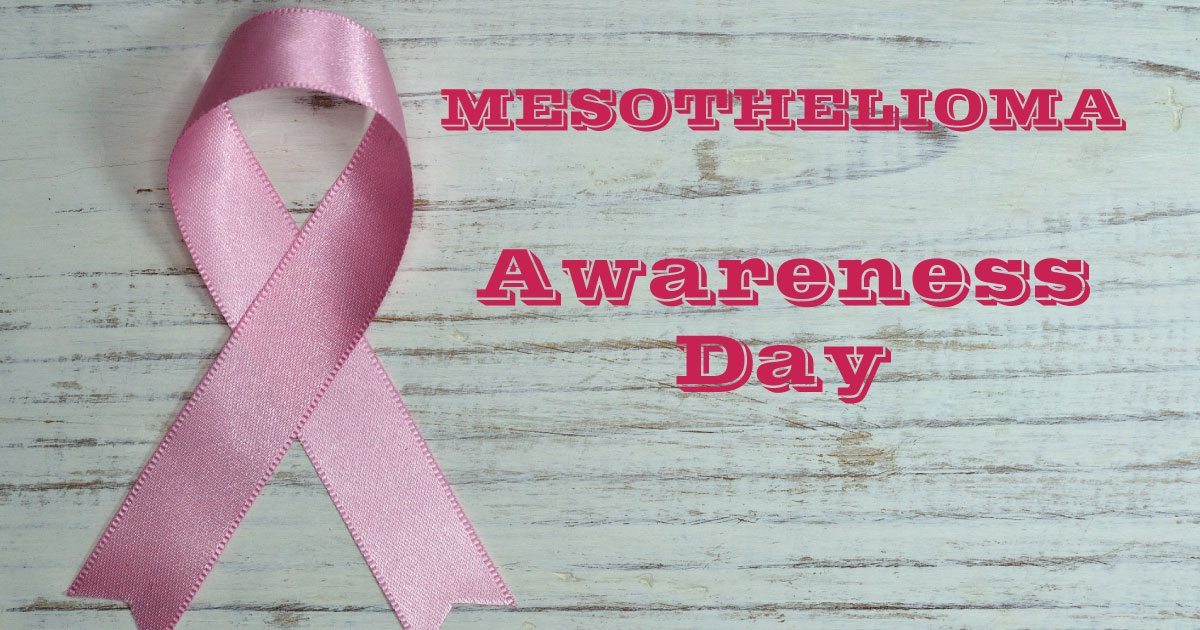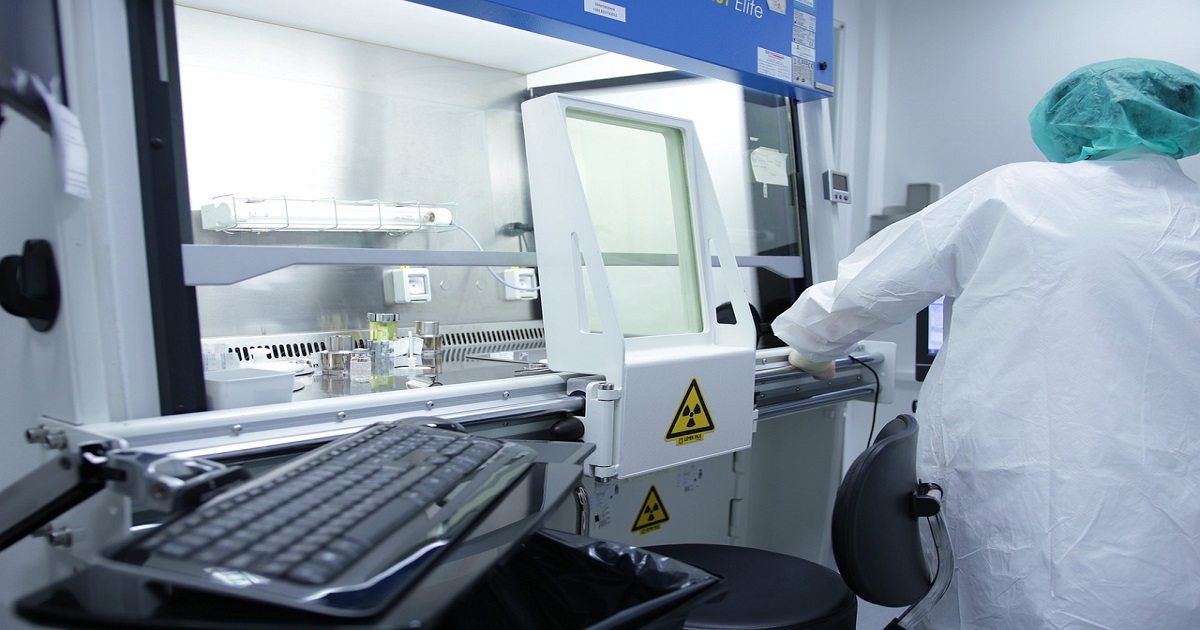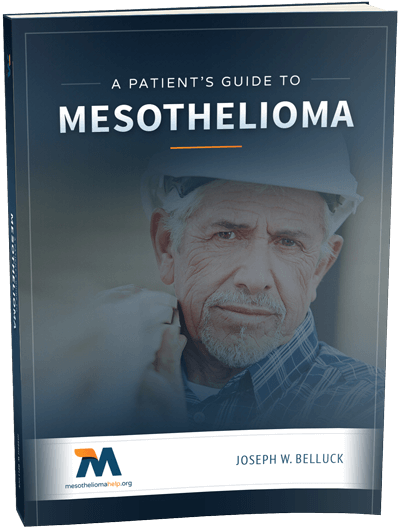Author: Nancy Meredith

September 26 Is National Mesothelioma Awareness Day
Each year, the mesothelioma community across the nation comes together for Mesothelioma Awareness Day, a time devoted to raising public awareness about the life-threatening cancer and its cause ─ exposure to asbestos.
Patients, family members, friends, advocates and health care professionals are encouraged to share their personal stories, struggles and inspiration in order to bring attention to the disease and further the search for a cure.
When Is Mesothelioma Awareness Day?
Mesothelioma Awareness Day is held on Sept. 26. In 2018, September 26 falls on a Wednesday.
In an effort to expand the impact of Mesothelioma Awareness Day, advocates have encouraged patients, caregivers, family and friends to participate in Mesothelioma Awareness Week surrounding Sept. 26, as well as Mesothelioma Awareness Month throughout September.
Mesothelioma Awareness Day History
In 2004, the Mesothelioma Applied Research Foundation organized the original Mesothelioma Awareness Day. Since then, the national nonprofit organization has continued to build momentum by promoting the day as a time for all those touched by the cancer to talk about its impact.
In 2010, Congress joined the effort by establishing Mesothelioma Awareness Day as a time for the nation to recognize that thousands of Americans are diagnosed with the preventable cancer each year. In fact, despite its designation as a known carcinogen, asbestos is still not banned in the United States, and Americans are still at risk of exposure.
The Importance of Awareness Day
The National Mesothelioma Awareness Day resolution asks that the President of the United States issue a proclamation calling for all Americans, federal agencies and departments, state governments, local municipalities, organizations, and news media to properly observe the day.
The Congressional Declaration outlines these key facts about malignant mesothelioma as reasons for promoting awareness of the deadly asbestos cancer:
- Although workers who were exposed to asbestos on a daily basis over a long period of time are most at risk of developing mesothelioma, even short-term exposures can cause the disease. In fact, exposure to asbestos for as little as one month can result in mesothelioma 20 to 50 years later.
- Asbestos materials were used in the construction of virtually all office buildings, public schools, and homes built before 1975. Still today, asbestos is used in more than 3,000 products being sold in the United States.
- The National Institutes of Health reported to Congress in 2006 that mesothelioma is a difficult disease to detect, diagnose and treat.
- For decades, the need to develop treatments for mesothelioma was overlooked. Still today, even the best mesothelioma treatments usually have a very limited effect, with the expected survival time of 8 to 14 months.
- It is believed that many of the firefighters, rescue workers and police officers from Ground Zero on September 11, 2001, may be at increased risk of developing mesothelioma in the future due to asbestos exposure at the site.
Every year, about 3,000 people in the United States are diagnosed with mesothelioma. Around the world, an estimated 38,400 people die each year from the devastating asbestos illness.
Unfortunately, those numbers are not dwindling. Mesothelioma statistics indicate an increase in deaths in recent years, with an 8 percent increase in fatalities in the United States for the 10-year period that ended in 2015.
These facts point to the importance of Mesothelioma Awareness Day in educating people about the dangers of asbestos and promoting the need for continued research into more effective treatments.
Paint the World in Mesothelioma Awareness
Just as breast cancer is associated with the color pink, support for mesothelioma awareness is often represented by a colored ribbon. The mesothelioma awareness color is blue or pearl.
Friends and family members of patients typically don pearl or blue ribbons in a show of solidarity with their loved ones who are fighting the life-threatening disease.
The Mesothelioma Applied Research Foundation also encourages people to participate in its “Paint the World in Mesothelioma Blue” campaign to raise awareness by wearing blue and sharing photos of themselves on social media.
How You Can Show Support on Mesothelioma Awareness Day
Since its founding, the nonprofit Mesothelioma Applied Research Foundation has advocated for patients and families while coordinating fundraising events to support research efforts related to the disease. This national organization is committed to finding a cure for mesothelioma and ending the suffering it causes.
One way to show your support on Mesothelioma Awareness Day is to make a donation to the Meso Foundation. Your contribution will help fund the organization’s efforts to support mesothelioma patients and the ongoing search for a cure.
You may also choose to show your support by wearing (and asking others to wear):
- Mesothelioma awareness ribbons
- Mesothelioma awareness pins
- Mesothelioma awareness bracelets
- Mesothelioma awareness wristbands
- Mesothelioma awareness shirts
At Mesothelioma Help Cancer Organization, we aim to raise awareness year-round, in particular through our Mesothelioma Awareness Scholarship Contest. As part of this contest, students submit essays sharing their own experiences with mesothelioma as well as their efforts for raising awareness of the dangers of asbestos. We encourage the students to share their essays on social media to help spread the word.
Quick Facts to Share on Mesothelioma Awareness Day
- Asbestos is the only known cause of mesothelioma. It has also been shown to cause lung cancer.
- Asbestos was commonly used on Navy ships and in shipyards. Veterans account for approximately one-third of mesothelioma diagnoses.
- Industrial workers and construction workers are at an increased risk of developing mesothelioma and other asbestos diseases.
- Family members of those who worked with asbestos may have faced secondhand exposure through fibers brought home on clothing or skin.
- Although the U.S. government has safety regulations in place, it has not banned the use of asbestos.
- There is no safe level of asbestos exposure.
- Renovation projects on older homes and demolition of older buildings can put people at risk of asbestos exposure.
- Never try to remove asbestos materials on your own. Contact an asbestos abatement professional.
- Companies that made asbestos products understood the health risks but failed to warn the public.
- Mesothelioma patients and families may be entitled to compensation for damages due to asbestos exposure.
- Even if an asbestos company has gone out of business, funds may be available in a bankruptcy trust for mesothelioma victims.
Sources:
- Mesothelioma Applied Research Foundation
https://www.curemeso.org/get-involved/get-involved-events/mesothelioma-awareness-day - Make a Donation
https://www.curemeso.org/donate

Global Study Shows Mesothelioma Deaths Continue to Rise
In March, MesotheliomaHelp presented information on the increasing number of mesothelioma cases in the U.S., but researchers continue to struggle to get a handle on the worldwide trend of mesothelioma. Now, in a newly released study, researchers concluded that globally, the incidence of mesothelioma cases has continued to rise.
An international team of researchers from Japan, Australia, the United States, the UK, Thailand and Singapore set out to determine the burden of mesothelioma deaths throughout the world. The team analyzed data from the World Health Organization’s mortality database of 230 countries for 1994 to 2014.
Realizing some countries are better at reporting mesothelioma cases, they broke the 230 countries into three groups:
- 59 countries with quality mesothelioma mortality data suitable to be used for reference rates;
- 45 countries with poor quality data; and,
- 126 countries with no data.
Using the countries reporting quality data, the researchers counted 15,011 mesothelioma deaths in the last three reporting years, 2011-2014. They then extrapolated from this information that the global number of mesothelioma deaths is 38,400 per year.
“The estimates are within the range of previously reported values but higher than the most recently reported values,” the researchers said.
Expert Insight
“The global numbers and rates of mesothelioma deaths have increased over time.”
While the researchers say the estimate depends on the validity of the data, they noted that their estimates “can be updated, refined and verified” from the commonly accessible data and their use of a “straightforward algorithm.”
Mesothelioma is a rare, aggressive cancer that is caused by past asbestos exposure. Although asbestos is banned in over 50 countries, a surprising number of them still mine asbestos and use the mineral in construction products. The U.S. has not banned the product and still imports over a 1,000 tons of it a year, according to the Asbestos Disease Awareness Organization.
When assessing the reported data, the researchers report that due to mesothelioma’s rarity and difficulty in diagnosing the disease, many countries are still struggling with accurate reporting. They also said reporting from even the “quality data” countries was not consistent. In fact, they said, “No country reported mesothelioma deaths for all of the 21 studied years.”
“Clearly, mesothelioma is a global health issue,” the team concluded.
Read the full study in the Sept. 2 issue of Occupational and Environmental Medicine.

Mesothelioma Community Excited About First-Ever Gene Therapy Approval From FDA
In July, MesotheliomaHelp reported on the pending approval of two different types of gene therapy for treating cancer and inherited diseases. Last week, the U.S. Food and Drug Administration announced approval of one of the therapies in a landmark approval of the first-ever gene therapy for a type of leukemia. The mesothelioma community is hopeful that this approval will lead to a new treatment for the incurable cancer.
In an August 30 press release, the FDA announced its “historic action” with the approval of Kymriah (tisagenlecleucel), from Novartis Pharmaceuticals Corp., for the treatment of a form of acute lymphoblastic leukemia (ALL). The press release conveyed an air of excitement in announcing that the first gene therapy approval in the United States is “ushering in a new approach to the treatment of cancer and other serious and life-threatening diseases.”
“We’re entering a new frontier in medical innovation with the ability to reprogram a patient’s own cells to attack a deadly cancer,” said FDA Commissioner Scott Gottlieb, M.D. “New technologies such as gene and cell therapies hold out the potential to transform medicine and create an inflection point in our ability to treat and even cure many intractable illnesses.”
The FDA explains how the new therapy will work:
“Each dose of Kymriah is a customized treatment created using an individual patient’s own T-cells, a type of white blood cell known as a lymphocyte. The patient’s T-cells are collected and sent to a manufacturing center where they are genetically modified to include a new gene that contains a specific protein (a chimeric antigen receptor or CAR) that directs the T-cells to target and kill leukemia cells that have a specific antigen (CD19) on the surface. Once the cells are modified, they are infused back into the patient to kill the cancer cells.”
Known as CAR-T, the new therapy is a process that genetically alters a patient’s own cells to fight cancer. Mesothelioma medical professionals hold out hope that ultimately this gene therapy could ultimately bring an effective treatment to mesothelioma patients.
Expert Insight
Francis S. Collins, M.D., Ph.D., Dir. NIH
“I’m eager to see where our immunotherapy researchers take us next!”
In a 2013 article for MesotheliomaHelp, Ricki Lewis, a science writer with a PhD in genetics, wrote about CAR-T treatment saying, “An ingenious technique that has vanquished leukemia in a handful of patients is also being applied to mesothelioma.” She was referring to a mesothelioma clinical trial from the University of Pennsylvania that uses the “doctored T cells,” known as chimeric immune receptor (CIR) instead of CAR, against mesothelin, a protein that is found to be in excess in mesothelioma and other cancers. The idea is that T cells led to the mesothelioma cells will attract an immune response, said Lewis.
Find out more about the mesothelioma clinical trial from University of Pennsylvania here.
Although the Director of the National Institutes of Health, Francis S. Collins, M.D., Ph.D., heralds immunotherapy as “one of the most exciting areas of progress” in cancer treatment, he notes caution should be taken in the widespread use of the drug, according to an Aug. 30 NIH Director’s Blog entry.
“Many questions must be addressed before we can herald immunotherapeutic approaches to cancer an unqualified success,” said Collins. “There are still too many severe reactions, too many non-responses or relapses, and, potentially, a very high price tag for their widespread use, which will be truly challenging to scale up. But we’re off to a promising start.”
Mesothelioma is a cancer caused by past exposure to asbestos. Nearly 3,000 Americans are diagnosed with the terminal cancer each year.
Sources:
- August 30 press release
https://www.fda.gov/NewsEvents/Newsroom/PressAnnouncements/ucm574058.htm - NIH Director’s Blog
https://directorsblog.nih.gov/2017/08/30/fda-approves-first-car-t-cell-therapy-for-pediatric-acute-lymphoblastic-leukemia - mesothelioma clinical trial
https://clinicaltrials.gov/ct2/show/NCT01590472

Older Mesothelioma Patients “Less Likely” to Receive Treatment
Last week, MesotheliomaHelp reported on the benefits of mesothelioma patients receiving trimodal therapy. Now, in another study aimed at better understanding the patterns of mesothelioma care and the associated survival, researchers found a startling number of untreated mesothelioma patients in the U.S.
Researchers from the National Cancer Institute reviewed the data of mesothelioma patients, identified as such from the Surveillance, Epidemiology, and End Results (SEER) Program of the NCI. SEER provides information on cancer statistics in an effort to reduce the cancer burden among the U.S. population. The data backed findings that mutli-modal therapy is best, however, the researchers discovered that nearly one-third of U.S. mesothelioma patients do not receive cancer therapy.
The study reviewed records of 389 pleural mesothelioma patients and 53 non-pleural mesothelioma patients, all of who were diagnosed in 2011. The researchers highlight the following key points of the study:
- 29.3% of the pleural mesothelioma patients and 21.5% of the non-pleural patients do not receive cancer therapy.
- Older pleural patients [older than 70-years] were less likely to receive therapy.
- Median survival was 8 months among pleural mesothelioma patients and 18 months among non-pleural mesothelioma patients.
- Among pleural mesothelioma patients receipt of surgery and systemic therapy was associated with the best survival.
Further information showed that, not surprisingly, younger pleural mesothelioma patients had better survival. In addition, 60 percent of the patients received some form of systemic treatment, which includes chemotherapy and immunotherapy, although the older population was “less likely” to undergo the treatments.
Patients may refuse treatment for a variety of reasons, and understanding and respecting the wishes of a patient is important. Read how one nurse explains a “Mesothelioma Patients’ Treatment Plans Can Match Their Wants.”
Of concern to the team is the fact that with all the mesothelioma research being done to find an effective treatment, and potentially a cure for the now incurable cancer, nearly one-third of the patient population could be missing out on extended survival.
Expert Insight
Lindsey Enewold, PhD, MPH, NCI
“Our findings indicate that only a subset of mesothelioma patients realize the benefit of established treatment options.”
The researchers point out that clinical trials “offer the best hope of finding more effective treatments for mesothelioma,” yet still, less than 5% of pleural mesothelioma patients and less than 2% of the non-pleural mesothelioma patients actually participated in a trial.
“Expanding our understanding of the particular challenges to participation in clinical trials in mesothelioma is essential to making an impact on this disease,” reported the researchers.
“These findings indicate the need for efforts to ensure equitable application of currently available therapies to all patients,” concluded the authors.
According to the NCI, the major cause of malignant mesothelioma is exposure to asbestos, including people who were exposed to asbestos in the workplace and their family members. Development of mesothelioma from asbestos exposure via a loved one is called second hand exposure. Exposure to asbestos can lead to mesothelioma decades later. Nearly 3,000 Americans are diagnosed with mesothelioma each year.
Read the full study, “Patterns of care and survival among patients with malignant mesothelioma in the United States,” in the August 10 journal Lung Cancer.
http://www.lungcancerjournal.info/article/S0169-5002%2815%2900157-9/abstract

New Mesothelioma Treatment May Result From Study Focusing on The Deadliest Subtype of Lung Cancer
In February, MesotheliomaHelp reported on research from the Mayo Clinic that pointed to the Ect2 gene as a target to slow tumor growth in KRAS-positive lung cancer and mesothelioma patients. Now, in another study, researchers believe they have found one more way to fight this deadly sub-type of lung cancer.
Researchers from Norton Thoracic Institute, headquartered at Dignity Health St. Joseph’s Hospital and Medical Center in downtown Phoenix, focused their research on lung cancers expressing the KRAS and/or the LKB1 gene noting that these “mutations are associated with aggressive disease progression and poor patient prognosis, and have been historically difficult to treat.”
The team looked at the use of a WEE1 kinase inhibitor, AZD1775, an experimental drug from AstraZeneca available to researchers only, as an effective treatment in the KRAS or LKB1 expressed lung cancer population. The drug could lead to apoptosis, or cell death, upon treatment with chemotherapeutic agents such as gemcitabine, cisplatin, carboplatin, according to AstraZeneca.
The team found that in a mouse model with the KRAS/LKB1 NSCLC cell lines, the combination of AZD1775 and cisplatin extended overall survival compared with cisplatin alone. In mesothelioma and lung cancer patients, cisplatin is one of the most common chemotherapy treatments used. It is often used in combination with other chemotherapeutic agents.
“In this study, we highlight a therapeutic strategy that may be effective in a group of lung cancer patients without rational therapeutic options,” said Timothy Whitsett, PhD, assistant professor at Norton Thoracic Institute.
According to some reports, mutations of the KRAS gene (Kirsten rat sarcoma viral oncogene homolog) are found in 20 to 25 percent of lung cancers. These cancers do not respond well to standard treatments and are extremely challenging to treat. In a 2014 study conducted by Salk Institute researchers, the team found that lung cancer patients who have an alteration in the LKB1 gene had a “much greater rate” of metastasis.
Kinases function as drivers of a variety of forms of cancer, including mesothelioma. Many researchers have found that kinases are involved in the gradual transformation of normal tissue in the lining of the lung into malignant pleural mesothelioma after exposure to asbestos. Thus, the use of kinase inhibitors, such as AZD1775, should slow cancer growth.
Landon Inge, PhD, co-author and assistant professor, said, “We hope these findings spur new explorations for targeting this molecular subgroup, leading to better clinical trial design in the near future.”
The researchers plan to continue this research to identify patients “who will most likely benefit from the use of this type of therapy, and to inform future clinical trial design by selecting lung cancer patients with difficult to treat molecular alterations.”
Care for mesothelioma, a rare form of cancer caused by exposure to asbestos fiber, often follows the same protocol as lung cancer. Positive results in this study can mean positive results for mesothelioma patients. Approximately 3,000 Americans are diagnosed with mesothelioma each year. Currently, there is no known cure for the cancer.
Read the results of the study in the August 15 issue of Cancer Research.
Sources
- Cancer Research
http://cancerres.aacrjournals.org/content/early/2012/04/25/0008-5472.CAN-11-3481.abstract?sid=c98a9479-15e8-43da-8088-356c133a2536 - Mayo Clinic
http://newsnetwork.mayoclinic.org/discussion/mayo-researchers-identify-mechanism-of-oncogene-action-in-lung-cancer - Norton Thoracic Institute
https://www.dignityhealth.org/arizona/locations/stjosephs/about-us/press-center/press-releases/2017-08-18-researchers-discover-a-novel-therapeutic-strategy
Free Mesothelioma Patient & Treatment Guide
We’d like to offer you our in-depth guide, “A Patient’s Guide to Mesothelioma,” absolutely free of charge.
It contains a wealth of information and resources to help you better understand the condition, choose (and afford) appropriate treatment, and exercise your legal right to compensation.
Download Now